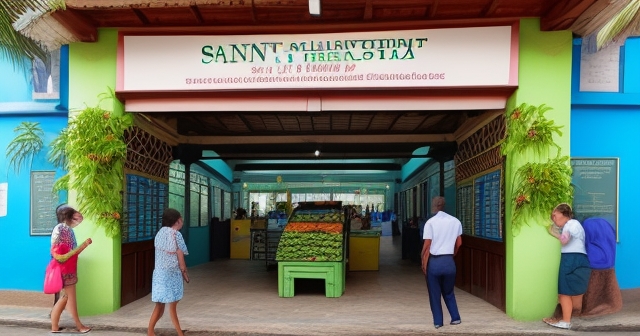“`html
Understanding the Saint Helena Pound and its Economic Context
Welcome to a deeper exploration of island economics and currency dynamics. Today, we focus our lens on a fascinating case study: Saint Helena and its unique currency, the Saint Helena Pound (SHP). Situated remotely in the South Atlantic, St Helena presents a distinct economic environment, one shaped significantly by its geography, population size, and relationship with external partners. For investors and those simply curious about how different economies function, understanding places like St Helena offers valuable perspective on the interplay between governance, external support, and local financial instruments like the Saint Helena pound.
When we look at an economy, especially a micro-economy like St Helena’s, we consider several foundational pillars. These typically include local production and trade, government financial management, external economic links (like aid and investment), and of course, the performance of its currency. In the case of the Saint Helena pound, its value and stability are intrinsically linked to these factors, particularly the significant financial support received from abroad and the island government’s strategic financial planning. This article aims to guide you through these key areas, providing insight into the recent economic landscape of St Helena based on available data.

Have you ever considered how a small island nation sustains its public services or invests in its future? For St Helena, like many small island developing states (SIDS), external financial aid plays a crucial, foundational role. This isn’t just about covering deficits; it’s about enabling essential services and funding growth initiatives that would be impossible through the local tax base and economic activity alone. We will delve into a recent significant development regarding this external support, understanding its nature and implications for the Saint Helena Government (SHG) and the island’s overall economic health.
Beyond government finance, the performance of the local currency is a key indicator and a practical concern for residents, businesses, and anyone engaging with the island. The Saint Helena pound is a tangible representation of the island’s economic interface with the rest of the world, particularly through its exchange rate against major global currencies like the US dollar (USD). Tracking these rates offers a real-time glimpse into how the SHP’s value is performing, influenced by broader currency market dynamics. Let’s embark on this journey to understand the Saint Helena pound and the economic forces shaping its reality.
The Foundation: External Financial Support for St Helena
For any government, securing sufficient funding is paramount to delivering public services, maintaining infrastructure, and fostering development. For the Saint Helena Government (SHG), a significant portion of its annual operational budget is supported through external financial aid. This isn’t unusual for small, isolated economies that face unique challenges in generating sufficient internal revenue to cover the costs of modern governance and public welfare.
| Year | Funding Amount (£) | Purpose |
|---|---|---|
| 2023/24 | £32 million | Operational expenses |
| 2024/25 | £34 million | Public services |
| 2025/26 | £35.79 million | Continued operational support |
Recently, a crucial piece of information emerged regarding this vital support: the UK Government, through its Foreign, Commonwealth & Development Office (FCDO), has made a substantial commitment to St Helena’s financial future. This commitment comes in the form of recurrent funding, which is distinct from project-specific aid and is essential for covering the day-to-day operational costs of the government. Think of recurrent funding as the electricity bill, salaries, and basic maintenance costs required to keep the lights on and essential services running. Without it, the very machinery of government would struggle to function effectively.
Specifically, the UK Government has committed £35.79 million in recurrent funding to the Saint Helena Government for the 2025/26 financial year. This allocation is a cornerstone of the SHG’s annual budget planning. It provides a level of financial predictability and stability that is absolutely critical for long-term planning and service delivery in a small administration. Imagine trying to run a school or hospital without knowing if you’ll have the basic funds for staff and supplies next year – that’s the uncertainty this recurrent funding helps to alleviate.
This commitment underscores the ongoing relationship between the UK and St Helena, highlighting the former’s role in supporting the latter’s governance and economic stability. Understanding the scale and nature of this funding is the first step in appreciating the broader economic context in which the Saint Helena pound operates. It signifies a fundamental reliance on external support that shapes the island’s fiscal policy and development trajectory.
Decoding the £35.79 Million Allocation: More Than Just a Number
Let’s look closer at that £35.79 million figure for the 2025/26 financial year. While the absolute number might seem modest compared to the budgets of larger nations, it represents a significant sum in the context of St Helena’s economy. More importantly, analyzing the specifics provides deeper insights into the island’s financial health and the support it receives.
| Funding Source | Type of Funding | Allocation Highlights |
|---|---|---|
| UK Government | Recurrent Funding | Essential services support |
| International Aid | Project-Based Funding | Initiatives and development projects |
| Local Revenue | Domestic | Tax income and local business contributions |
The data indicates that this allocation represents an increase of over 5% from the previous funding period. Why is this increase noteworthy? In economic terms, a >5% rise in recurrent funding suggests either rising operational costs for the SHG (perhaps due to inflation, increased demand for services, or new initiatives) or a deliberate decision by the UK to provide enhanced support. For a small economy, even a modest percentage increase in core funding can have a tangible impact on the government’s capacity to function and serve its population.
Consider the implications of this increase. A larger budget, supported by external aid, means the SHG has potentially more resources available for essential public services like healthcare, education, infrastructure maintenance, and social welfare programs. It can allow for necessary investments in human capital or operational efficiencies. This enhanced capacity, directly fueled by the UK’s financial aid, is fundamental to the quality of life on the island and the smooth operation of the government.
Moreover, the consistency of this recurrent funding, year after year, coupled with an increase, sends a positive signal about the stability of external support. For businesses on the island and potential external investors, this stability is a critical factor. It suggests that the foundational economic environment, though externally supported, is reliable. This reliability is an indirect, yet important, contributor to the overall confidence in the Saint Helena Government and, by extension, the economic system where the Saint Helena pound is the medium of exchange.
This funding isn’t merely a transfer of money; it’s an enabler of governance and a pillar of economic continuity. Its scale and recent increase highlight the unique fiscal realities of small island economies and the vital role that international partnerships play in their sustainability. As we delve further into the SHG’s economic management and the Saint Helena pound’s performance, keep in mind the foundational importance of this external financial bedrock.
Navigating St Helena’s Economic Landscape: The Role of Government Portfolios
Understanding how the Saint Helena Government (SHG) manages its economy and utilizes the funds it receives is key to appreciating the environment in which the Saint Helena pound functions. The SHG operates through various portfolios, each responsible for different aspects of governance and economic activity. These portfolios are essentially the engines that translate financial resources into tangible services and development initiatives on the island.

Key portfolios with significant roles in the economic and financial sphere include the Treasury, Infrastructure, and Sustainable Development. The Treasury, as in any government, is the heart of financial management. It oversees Corporate Finance, budgeting, accounting, and fiscal policy. This is where decisions about how the allocated funds are managed, spent, and accounted for are made. The efficiency and transparency of the Treasury’s operations are vital for ensuring that the financial aid and locally generated revenue are used effectively.
The Infrastructure portfolio is responsible for developing and maintaining the physical backbone of the island – roads, utilities, public buildings, and connectivity. Investment in infrastructure is often funded through a combination of recurrent budget allocation and specific development programs. A robust infrastructure is essential for supporting economic activity, facilitating trade, and improving the quality of life for residents. The funds directed towards infrastructure projects directly impact the local economy through employment and procurement.
The Sustainable Development portfolio typically encompasses areas aimed at fostering economic growth, environmental protection, and social well-being. This includes oversight of Trade, Investment, and specific programs designed to diversify the economy and create opportunities. Initiatives within this portfolio often involve using public funds to stimulate private sector activity, support local businesses, and attract external investment. These activities directly involve the Saint Helena pound as the primary currency for local transactions and labor costs.
These government portfolios, working in concert, manage the flow of money within the island’s economy. They are the practical administrators of the budget, including the recurrent funding from the UK. Their strategies and operational effectiveness directly influence the economic stability of St Helena and create the environment where the Saint Helena pound circulates and holds value. Think of them as the various departments of a company, each managing a piece of the overall operation to achieve the organizational goals – in this case, the sustainable development and well-being of St Helena.
The Engine of Development: Exploring the Economic Development Investment Programme (EDIP)
Within the framework of the Sustainable Development portfolio and the broader government strategy, programs specifically designed to stimulate growth play a crucial role. One such initiative is the Economic Development Investment Programme (EDIP). While the specific details of EDIP projects can vary, the core purpose of such a program is universally focused on fostering economic activity and attracting investment to the island.

The EDIP is an example of how the Saint Helena Government utilizes both its recurrent budget allocation and potentially additional capital funding (which may also come from external sources) to drive strategic economic goals. What kinds of activities might an EDIP support? It could include funding for small business development, infrastructure upgrades specifically aimed at supporting tourism or export industries, initiatives to improve trade links, programs to attract foreign investment, or projects focused on developing new economic sectors like sustainable tourism or specialized agriculture.
The success of the EDIP is vital for St Helena’s long-term aspiration of increasing self-sufficiency and reducing reliance on external aid. By creating jobs, generating local revenue, and stimulating private sector growth, these programs aim to build a more resilient and dynamic local economy. The funds disbursed through EDIP, whether for grants, loans, or direct investment by the government, are primarily channeled through the local financial system, involving the Saint Helena pound.
For businesses and individuals on the island, the EDIP represents opportunities for growth and support. For potential external investors, it signals areas where the government is actively seeking partnership and providing facilitation. Understanding programs like EDIP gives us insight into the forward-looking strategies of the SHG and how they intend to leverage available resources, including the essential recurrent funding, to shape the island’s economic future. It’s a critical piece of the puzzle when assessing the overall economic health and potential of St Helena, and by extension, the underlying strength supporting the Saint Helena pound.
Introducing the Saint Helena Pound (SHP): A Unique Currency
Every distinct economy has its medium of exchange, its official currency. For St Helena, Ascension, and Tristan da Cunha, that currency is the Saint Helena Pound (SHP). Issued by the Government of Saint Helena, the SHP is legal tender on these islands. But what gives the SHP its value and how does it interact with the global financial system?
| Feature | Details |
|---|---|
| Pegged Currency | SHP is pegged at par to GBP |
| Currency Exchange | Directly mirrors GBP performance |
| Purchasing Power | Aligns with GBP purchasing power |
The most crucial characteristic of the Saint Helena pound is its peg to the British Pound Sterling (GBP). Since 1984, the SHP has been fixed at par with the GBP, meaning £1 SHP is always equal to £1 GBP. This is not a floating exchange rate where the value is determined purely by market forces; it’s a fixed peg maintained by the Government of Saint Helena, presumably through arrangements that involve holding reserves in GBP.
What does a fixed peg mean in practice? It means that the purchasing power of the Saint Helena pound locally should, in theory, align closely with that of the British Pound. For anyone on the island dealing with GBP (e.g., receiving remittances from the UK, or in this context, the SHG receiving funding in GBP), the exchange is straightforward: one for one. This simplifies transactions and removes exchange rate risk *relative to GBP* for those holding or dealing with the two currencies.
However, this fixed peg also means that the SHP’s value against *other* world currencies is entirely dependent on the GBP’s value against those currencies. For example, the SHP to US dollar (SHP/USD) exchange rate isn’t directly determined by supply and demand for SHP versus USD. Instead, it is a derivative rate, calculated based on the GBP/USD exchange rate. If £1 GBP equals $1.25 USD, then £1 SHP also equals $1.25 USD. If the GBP strengthens against the USD, the SHP will strengthen against the USD by the same proportion, and vice-versa.

This fixed peg strategy provides stability relative to the UK economy, which is the source of significant financial support and trade links. It also simplifies monetary policy for the SHG, as they essentially adopt the monetary policy stance of the Bank of England. However, it also means the SHP’s value against non-GBP currencies is subject to fluctuations in the international foreign exchange market driven by factors affecting the British Pound.
Tracking the SHP/USD Exchange Rate: Recent Performance Insights
Given the SHP’s peg to the British Pound, understanding its performance against the US dollar requires looking at the dynamics of the GBP/USD pair. The data provided gives us a snapshot of the Saint Helena pound’s value relative to the US dollar as of a specific recent date, April 24, 2025.
According to this data, the mid-market exchange rate was £1.000 SHP = $1.334 USD. The mid-market rate is typically the midpoint between the buy and sell prices for a currency pair, representing a fair value before transaction costs are applied. This rate tells us that on that particular day, one Saint Helena pound could effectively be exchanged for 1.334 US dollars on the wholesale market.
The data also provides insights into recent short-term movements. It indicates a 0.520% change since the previous day and a 0.528% increase over the past week (as of the update date). What do these percentages tell us? A daily increase of 0.520% means that the SHP (and by extension, the GBP) strengthened slightly against the US dollar in the 24 hours leading up to the data point. Similarly, the 0.528% increase over the week indicates a marginal strengthening trend for the SHP against the USD over that period.

While these daily and weekly movements might seem small, such percentage changes are quite typical in the foreign exchange market for major pairs like GBP/USD. They are influenced by a multitude of factors, including economic data releases (like inflation, employment figures), central bank announcements, geopolitical events, and shifts in market sentiment. Since the SHP is pegged to the GBP, these same global and UK-specific factors are indirectly driving the SHP/USD rate.
For someone on St Helena, a strengthening SHP against the USD means that goods imported from the US or priced in USD (like oil or certain commodities) become slightly cheaper in SHP terms. Conversely, for someone in the US looking to spend USD on St Helena (perhaps as a tourist), their dollars buy fewer Saint Helena pounds when the SHP strengthens against the USD.
Historical Perspective: Analyzing SHP/USD Fluctuations Over Six Months
While recent movements provide a snapshot, looking at the historical performance of the SHP/USD exchange rate over a longer period, such as six months, gives us a better sense of its volatility and trading range. The provided data offers key points from the six months preceding April 24, 2025.
| Date | SHP/USD Rate | Fluctuation |
|---|---|---|
| January 18, 2025 | 1.2168 | Lowest |
| April 22, 2025 | 1.3379 | Highest |
| Average | 1.2708 | – |
Within that roughly six-month window, the SHP/USD rate experienced a notable range of fluctuation. The data points to a high of 1.3379 USD reached on April 22, 2025, very close to the reporting date. The low point within this period was significantly lower, hitting 1.2168 USD on January 18, 2025. This range – from 1.2168 to 1.3379 – represents a difference of approximately 0.12 USD for every Saint Helena pound. This magnitude of variation over six months highlights that while pegged to GBP, the SHP/USD rate is subject to the substantial fluctuations inherent in the GBP/USD market.
The average SHP/USD rate over this six-month period was approximately 1.2708 USD. Comparing the current rate of 1.334 USD to this six-month average shows that the SHP was trading significantly above its recent historical average as of late April 2025. This suggests that the GBP, and consequently the SHP, had seen a period of strengthening against the US dollar leading up to that date compared to the average performance over the preceding half year.
What does this historical fluctuation tell us? For investors or traders looking at currency pairs, a range of ~12 cents on a rate around 1.20-1.30 represents a significant level of volatility over six months. While not as volatile as some emerging market currencies, it demonstrates that the Saint Helena pound’s external value, dictated by GBP, is not static. It moves considerably based on global economic forces and policy decisions primarily affecting the UK and the US.
Understanding this historical range is important for forecasting or analyzing potential future movements. While a fixed peg removes the *local* factors from influencing the SHP/USD rate directly, it fully exposes it to the volatility of the underlying GBP/USD pair. Traders interested in the GBP/USD pair would find this historical context familiar, as it reflects the market dynamics between those two major currencies during that period. For someone dealing with SHP internationally, these fluctuations directly impact the USD cost of goods or services, or the USD value of funds held in SHP.
Why Exchange Rates Matter: Impact on Trade, Tourism, and Daily Life
While the previous sections discussed government finance and the mechanics of the Saint Helena pound’s peg, it’s crucial to connect these concepts to the practical impact on the island’s economy and its people. The exchange rate, particularly the SHP/USD rate, plays a significant role in various aspects of life and economic activity on St Helena.
Consider trade: St Helena imports a substantial portion of its goods, from food and fuel to manufactured items. Many of these imports are likely priced in major currencies like USD, EUR, or GBP. Since the SHP is pegged to GBP, the SHP cost of imports from the UK is relatively stable (ignoring inflation). However, for imports priced in USD, the cost in SHP terms fluctuates directly with the SHP/USD rate. If the SHP strengthens against the USD (the rate increases, e.g., from 1.20 to 1.30), imports from the US become cheaper for those paying in SHP. If the SHP weakens (the rate decreases), those imports become more expensive. Given the island’s reliance on imports, exchange rate movements can have a tangible impact on local prices and the cost of living.
Tourism is another area affected by the exchange rate. St Helena is increasingly promoting tourism as a potential driver of economic growth. Tourists arriving with foreign currency, particularly USD, will find the purchasing power of their money on the island directly linked to the SHP/USD rate. When the SHP is weaker against the USD, American tourists (or those holding USD) find their dollars buy more on St Helena, making the destination potentially more attractive. Conversely, a stronger SHP/USD rate means their dollars buy less, potentially impacting tourism expenditure.

Even for daily life, exchange rates matter. While most domestic transactions use SHP, individuals or businesses needing to send money abroad, receive funds internationally, or pay for online services in foreign currency will encounter exchange rates. The SHP/USD rate determines how many USD you get for your SHP, or how many SHP you need to buy a certain amount of USD. This affects everything from paying for overseas education to purchasing goods from international websites.
In essence, the SHP/USD exchange rate acts as a bridge between the local Saint Helena economy and the global one. Its movements, though dictated by the GBP/USD pair, have real-world consequences for affordability, trade balance, and the economic viability of key sectors like tourism. Understanding these impacts helps us see why tracking currency values isn’t just an exercise for traders, but is relevant to the broader economic health and daily realities on the island.
The Interplay of Funding and Currency Value: A Macro View
We’ve discussed the critical role of external funding for the Saint Helena Government and the dynamics of the Saint Helena pound’s exchange rate. Now, let’s consider how these two major themes might intersect from a macro-economic perspective.
While the SHP’s value against non-GBP currencies is technically determined by the GBP’s performance on the global market due to the peg, the underlying economic health and stability supported by the external funding can still have indirect effects or be viewed through a related lens. Significant and stable recurrent funding, like the £35.79 million committed by the UK, provides a crucial foundation of economic stability for St Helena. This stability reduces fiscal risk for the government and ensures the continued provision of essential services, which are fundamental prerequisites for any economic activity to flourish.
A stable government, capable of managing its finances and investing in infrastructure and development (like through the EDIP), creates a more predictable environment for businesses and potential investors. While this domestic stability doesn’t directly move the SHP/USD exchange rate (again, that’s a function of GBP/USD), it can contribute to confidence in the Saint Helena economy overall. Over the long term, successful economic development efforts, potentially enabled by this funding, could lead to increased local revenue generation, reduced reliance on aid, and a stronger, more diversified economy. A stronger underlying economy, while not breaking the peg, could theoretically enhance the island’s attractiveness for investment and trade, which in turn could influence capital flows, albeit within the constraints of the fixed exchange rate system.
Furthermore, the very fact that the UK provides this level of support can be seen by external observers as an indicator of the UK’s commitment to the island’s stability. This perception of stable governance and external backing, though difficult to quantify in terms of direct currency impact under a fixed peg, contributes to the overall country risk assessment. For investors considering putting money into St Helena-based ventures (which would involve dealing with the Saint Helena pound), the knowledge of this reliable external support is likely a positive factor.
In essence, while the SHP’s external value against currencies like the USD dances to the tune of the GBP/USD pair, the music of St Helena’s domestic economic health and stability is heavily composed of the notes provided by external financial aid and the government’s management of those funds. These two elements, external support and currency dynamics, are distinct mechanisms but together they paint a picture of St Helena’s unique position in the global economic landscape.
Accessing SHP: Understanding Currency Exchange and Transfer Limitations
For anyone outside St Helena wishing to acquire or transact in Saint Helena Pounds, or for residents needing to move money internationally, the process involves currency exchange. As we’ve discussed, the SHP is pegged to the GBP at par, which simplifies exchange with British Pounds. However, exchanging SHP directly for other currencies, like the US dollar, involves the prevailing SHP/USD rate (which mirrors the GBP/USD rate).
Accessing and exchanging smaller, less globally traded currencies like the Saint Helena pound can sometimes present logistical challenges compared to major currency pairs. While traditional banking channels on the island facilitate exchanges, using international money transfer services or foreign exchange platforms might have specific limitations for SHP. The provided data mentions that certain service limitations exist for direct money transfers between SHP and USD via some platforms. This is not uncommon for currencies that are not widely traded on the global interbank market.
These limitations mean that you might not find SHP listed on every major online currency exchange platform or readily available for direct conversion in every country. Typically, the process might involve converting SHP to GBP first (at the 1:1 peg) and then converting GBP to USD (at the prevailing GBP/USD rate). Alternatively, some specialized services might offer direct SHP/USD conversion, but their availability and rates can vary.
For investors and traders, this highlights a key point: not all currencies are equally accessible for trading. While you can track the SHP/USD rate, directly trading the Saint Helena pound against the US dollar on international Forex platforms is generally not possible. Traders interested in profiting from the SHP/USD movements would effectively be trading the GBP/USD pair, as the SHP’s value follows the GBP exactly. This underscores the importance of understanding the underlying structure (the peg) when considering any interaction with the Saint Helena pound’s external value.
While direct SHP to USD trading might have limitations on some platforms, the principles of understanding exchange rates are fundamental to all currency pairs traded globally. If you’re curious about diving into the broader world of foreign exchange trading or exploring Contracts for Difference (CFDs) on various financial instruments, choosing the right platform is key. If you’re considering starting out in Forex trading or exploring more CFD instruments, Moneta Markets is a platform worth considering. Hailing from Australia, it offers over 1000 financial instruments, catering to both novice and professional traders alike. Understanding currency dynamics, whether for SHP or major pairs like EUR/USD or GBP/USD, is the first step towards navigating the global financial markets.
Conclusion: A Look Ahead for the Saint Helena Economy and the SHP
We have journeyed through the key facets shaping the economic reality of St Helena, from the critical role of external financial aid to the dynamics of its unique currency, the Saint Helena pound. The recent commitment of £35.79 million in recurrent funding from the UK Government for 2025/26 stands as a testament to the continued support vital for the island’s operational stability and ability to fund essential public services and development initiatives. This funding, representing an increase, is the financial bedrock upon which the Saint Helena Government builds its annual budget and executes its economic strategies through portfolios like Treasury and Sustainable Development.
The Saint Helena pound, pegged at par to the British Pound Sterling, serves as the island’s indispensable medium of exchange. Its value against major currencies like the US dollar is not determined locally but is a direct reflection of the dynamic GBP/USD exchange rate on the international market. Recent data showed the SHP/USD rate around 1.334, having seen slight positive movements in the short term. Looking back over six months revealed a notable range of fluctuation, from a low of 1.2168 to a high of 1.3379, highlighting the volatility inherent in the GBP/USD pair that the SHP’s external value mirrors. This volatility, while not driven by St Helena’s micro-economy, has real impacts on the island’s trade, tourism, and the daily cost of living.
Understanding the interplay between the government’s fiscal management (supported by external aid) and the currency’s performance (driven by the GBP peg) provides a comprehensive picture of St Helena’s economic structure. The challenges of a small, isolated economy are significantly mitigated by reliable external funding, enabling the government to focus on fostering development through initiatives like the EDIP, aiming for greater self-sufficiency in the long term. While direct trading of SHP on global platforms may have limitations, its peg to GBP means that anyone interested in its external value should focus on the dynamics of the British Pound.
As St Helena continues its path of development, the relationship between external support, government effectiveness, and the stability of the Saint Helena pound will remain central to its economic narrative. For those involved with or interested in the island, keeping an eye on these foundational elements provides valuable insight into the unique economic landscape of this remarkable territory.
saint helena poundFAQ
Q:What is the exchange rate of the Saint Helena Pound (SHP) to the US Dollar (USD)?
A:The exchange rate as of April 24, 2025, is approximately £1 SHP = $1.334 USD.
Q:How is the Saint Helena Pound related to the British Pound Sterling?
A:The Saint Helena Pound is pegged at par to the British Pound Sterling, meaning £1 SHP is always equal to £1 GBP.
Q:What role does external funding play in St Helena’s economy?
A:External funding is crucial for supporting public services, infrastructure, and development initiatives within St Helena.
“`
